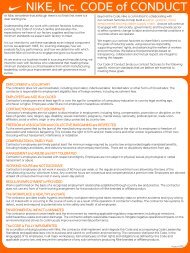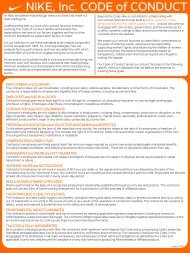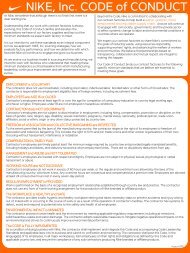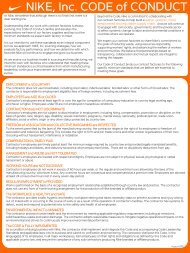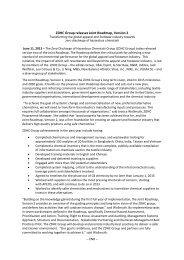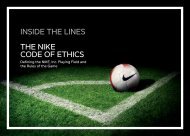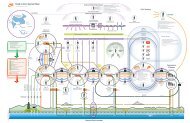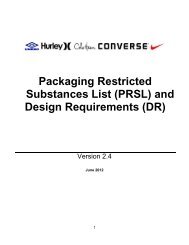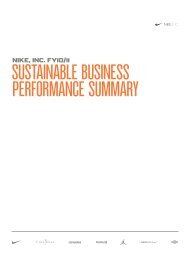COC CLS - Healthy Safety Environment - NIKE, Inc. - The Journey
COC CLS - Healthy Safety Environment - NIKE, Inc. - The Journey
COC CLS - Healthy Safety Environment - NIKE, Inc. - The Journey
Create successful ePaper yourself
Turn your PDF publications into a flip-book with our unique Google optimized e-Paper software.
MACHINE GUARDING<br />
b. Guards must be in good operating condition and securely in place.<br />
c. Guards must not create additional hazard.<br />
d. Fans and other rotating equipment located less than 2.1 meters (7 feet) above the working<br />
surface must be guarded with openings of less than 1.25 cm (0.5 in).<br />
e. Machines with rotating parts must be enclosed and interlocked with automatic shut off<br />
mechanism.<br />
f. Secure machines or equipment that can walk or move during operation.<br />
g. Annual inspections of guarding on machines.<br />
h. Preventative maintenance and repair meeting lockout/tagout requirements.<br />
3. ELEVATORS, ESCALATORS AND MATERIAL LIFTS—<br />
Risk Assessment: Each facility must have a documented risk assessment performed for elevators,<br />
escalators and material lifts which includes as a minimum:<br />
a. Identification of hazards associated operations and maintenance of elevators, escalators and<br />
material lifts.<br />
b. Evaluation of the risk associated with hazards.<br />
c. Identification and implementation of control measures to reduce the risk to an acceptable level<br />
(e.g., interlocks, preventative maintenance).<br />
Program: Each facility must implement procedures for elevators, escalators and material lifts which<br />
must cover as a minimum, the following:<br />
a. Indicate the safe lifting load. If equipment is not intended for human use, signage indicating<br />
such.<br />
b. Positioned or installed to prevent the risk of injury to users and bystanders.<br />
c. Interlocks, barriers and safety devices where appropriate must be properly installed and<br />
operational to prevent injury.<br />
d. Preventative maintenance performed regularly.<br />
e. Repair and maintenance activities adhere to lockout/tagout requirements.<br />
f. Barriers and signs used to prevent entry when equipment is inoperable.<br />
g. Procedures addressing elevator, escalator, and material lift use in the event of an emergency.<br />
h. Third party inspection and certification at intervals that meets local law.<br />
i. Vertical clearance to any overhead obstruction of at least 2.1 m (7 ft).<br />
<strong>Safety</strong> <strong>CLS</strong> – Page 2<br />
04.14.10



